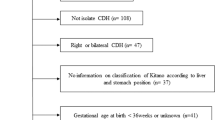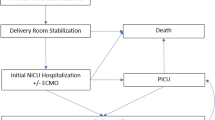Abstract
Objective
Congenital Diaphragmatic Hernia (CDH) is diagnosed prenatally in ~60% of cases. Prenatal measures typically guide management and prognostication. Simple postnatal prognosticators are needed when prenatal diagnosis is lacking. We hypothesized that preoperative orogastric tube (OGT) tip position relative to the contralateral diaphragm correlates with defect severity, resource utilization, and clinical outcomes regardless of diagnostic status.
Study design
150 neonates with left-posterolateral CDH were analyzed. Impact of intrathoracic and intraabdominal preoperative tip position on clinical outcomes was compared.
Results
Ninety-nine neonates were prenatally diagnosed. Overall, intrathoracic position significantly correlated with larger diaphragmatic defects, advanced postnatal pulmonary support requirements (HFOV, pulmonary vasodilators, and ECMO), operative complexity, longer hospitalization, and poorer survival to discharge. These observations persisted when analyzing only cases lacking prenatal diagnosis.
Conclusions
Preoperative OGT tip position predicts defect severity, resource utilization, and outcomes in CDH. This observation enhances postnatal prognostication and care planning for neonates without a prenatal diagnosis.
This is a preview of subscription content, access via your institution
Access options
Subscribe to this journal
Receive 12 print issues and online access
$259.00 per year
only $21.58 per issue
Buy this article
- Purchase on SpringerLink
- Instant access to full article PDF
Prices may be subject to local taxes which are calculated during checkout



Similar content being viewed by others
Data availability
The datasets generated and/or analyzed during the current study are available from the corresponding author on reasonable request.
References
Weinstein S, Stolar CJ. Newborn surgical emergencies. Congenital diaphragmatic hernia and extracorporeal membrane oxygenation. Pediatr Clin North Am. 1993;40:1315–33.
Wynn J, Krishnan U, Aspelund G, Zhang Y, Duong J, Stolar CJH, et al. Outcomes of congenital diaphragmatic hernia in the modern era of management. J Pediatr. 2013;163:114–119.
Boloker J, Bateman DA, Wung JT, Stolar CJH. Congenital diaphragmatic hernia in 120 infants treated consecutively with permissive hypercapnea/spontaneous respiration/elective repair. J Pediatr Surg. 2002;37:357–66.
Dumpa V, Chandrasekharan P Congenital Diaphragmatic Hernia. In: StatPearls [Internet]. Treasure Island (FL): StatPearls Publishing; 2022 [cited 2022 Mar 29]. Available from: http://www.ncbi.nlm.nih.gov/books/NBK556076/.
Garne E, Haeusler M, Barisic I, Gjergja R, Stoll C, Clementi M, et al. Congenital diaphragmatic hernia: evaluation of prenatal diagnosis in 20 European regions. Ultrasound Obstet Gynecol J Int Soc Ultrasound Obstet Gynecol. 2002;19:329–33.
Cordier AG, Russo FM, Deprest J, Benachi A. Prenatal diagnosis, imaging, and prognosis in congenital diaphragmatic hernia. Semin Perinatol. 2020;44:51163.
Danzer E, Rintoul NE, van Meurs KP, Deprest J. Prenatal management of congenital diaphragmatic hernia. Semin Fetal Neonatal Med. 2022;27:101406.
Chatterjee D, Ing RJ, Gien J. Update on congenital diaphragmatic hernia. Anesth Analg. 2020;131:808–21.
Mullassery D, Ba’ath ME, Jesudason EC, Losty PD. Value of liver herniation in prediction of outcome in fetal congenital diaphragmatic hernia: a systematic review and meta-analysis. Ultrasound Obstet Gynecol J Int Soc Ultrasound Obstet Gynecol. 2010;35:609–14.
Hedrick HL, Danzer E, Merchant AM, Bebbington MW, Zhao H, Flake AW, et al. Liver position and lung-to-head ratio for prediction of extracorporeal membrane oxygenation and survival in isolated left congenital diaphragmatic hernia. Am J Obstet Gynecol. 2007;197:422.e1–4.
Cordier AG, Jani JC, Cannie MM, Rodó C, Fabietti I, Persico N, et al. Stomach position in prediction of survival in left-sided congenital diaphragmatic hernia with or without fetoscopic endoluminal tracheal occlusion. Ultrasound Obstet Gynecol J Int Soc Ultrasound Obstet Gynecol. 2015;46:155–61.
Kitano Y, Okuyama H, Saito M, Usui N, Morikawa N, Masumoto K, et al. Re-evaluation of stomach position as a simple prognostic factor in fetal left congenital diaphragmatic hernia: a multicenter survey in Japan. Ultrasound Obstet Gynecol J Int Soc Ultrasound Obstet Gynecol. 2011;37:277–82.
Basta AM, Lusk LA, Keller RL, Filly RA. Fetal stomach position predicts neonatal outcomes in isolated left-sided congenital diaphragmatic hernia. Fetal Diagn Ther. 2016;39:248–55.
Metkus AP, Filly RA, Stringer MD, Harrison MR, Adzick NS. Sonographic predictors of survival in fetal diaphragmatic hernia. J Pediatr Surg 1996;31:148–51.
Deprest J, Brady P, Nicolaides K, Benachi A, Berg C, Vermeesch J, et al. Prenatal management of the fetus with isolated congenital diaphragmatic hernia in the era of the TOTAL trial. Semin Fetal Neonatal Med. 2014;19:338–48.
Jani J, Nicolaides KH, Keller RL, Benachi A, Peralta CFA, Favre R, et al. Observed to expected lung area to head circumference ratio in the prediction of survival in fetuses with isolated diaphragmatic hernia. Ultrasound Obstet Gynecol J Int Soc Ultrasound Obstet Gynecol. 2007;30:67–71.
Touloukian RJ, Markowitz RI. A preoperative x-ray scoring system for risk assessment of newborns with congenital diaphragmatic hernia. J Pediatr Surg. 1984;19:252–7.
Donnelly LF, Sakurai M, Klosterman LA, Delong DM, Strife JL. Correlation between findings on chest radiography and survival in neonates with congenital diaphragmatic hernia. AJR Am J Roentgenol. 1999;173:1589–93.
Holt PD, Arkovitz MS, Berdon WE, Stolar CJ. Newborns with diaphragmatic hernia: initial chest radiography does not have a role in predicting clinical outcome. Pediatr Radio. 2004;34:462–4.
Goodfellow T, Hyde I, Burge DM, Freeman NV. Congenital diaphragmatic hernia: the prognostic significance of the site of the stomach. Br J Radio. 1987;60:993–5.
Harting MT, Lally KP. The congenital diaphragmatic hernia study group registry update. Semin Fetal Neonatal Med. 2014;19:370–5.
R: The R Project for Statistical Computing [Internet]. Available from: https://www.r-project.org/.
Burgos CM, Frenckner B, Luco M, Harting MT, Lally PA, Lally KP, et al. Prenatally versus postnatally diagnosed congenital diaphragmatic hernia - Side, stage, and outcome. J Pediatr Surg. 2019;54:651–5.
Jancelewicz T, Brindle ME. Prediction tools in congenital diaphragmatic hernia. Semin Perinatol. 2020;44:151165.
Perrone EE, Karmakar M, Lally PA, Chung S, Kipfmueller F, Morini F, et al. Image-based prenatal predictors correlate with postnatal survival, extracorporeal life support use, and defect size in left congenital diaphragmatic hernia. J Perinatol J Calif Perinat Assoc. 2022;42:1195–201.
Niec JA, Achey MA, Wallace MW, Patel A, Zhao S, Hatch LD, et al. Congenital diaphragmatic hernia repair at the bedside or operating theater. Am Surg. 2022;88:1814–21.
ICMJE | Recommendations | Defining the Role of Authors and Contributors [Internet]. [cited 2023 Mar 11]. Available from: https://www.icmje.org/recommendations/browse/roles-and-responsibilities/defining-the-role-of-authors-and-contributors.html.
Author information
Authors and Affiliations
Contributions
All authors meet authorship criteria according to the ICMJE [27]. MW, JM, MA, JO and HL designed the experiment, collected data and critically revised and approved of the manuscript. MD, MH, LH and EM designed the experiment and critically revised and approved of the manuscript.
Corresponding author
Ethics declarations
Competing interests
The authors, Dr. Wallace, Dr. Niec, Dr. Achey, Dr. Danko, Dr. Oros, Dr. Hilmes, Dr. Hatch, Dr. Morris, and Dr. Lovvorn have no competing interests.
Additional information
Publisher’s note Springer Nature remains neutral with regard to jurisdictional claims in published maps and institutional affiliations.
Rights and permissions
Springer Nature or its licensor (e.g. a society or other partner) holds exclusive rights to this article under a publishing agreement with the author(s) or other rightsholder(s); author self-archiving of the accepted manuscript version of this article is solely governed by the terms of such publishing agreement and applicable law.
About this article
Cite this article
Wallace, M.W., Niec, J.A., Mirza, M.B. et al. Enteric tube position on preoperative radiographs predicts clinical outcomes in neonatal congenital diaphragmatic hernia with and without prenatal diagnosis. J Perinatol 43, 1131–1138 (2023). https://doi.org/10.1038/s41372-023-01712-6
Received:
Revised:
Accepted:
Published:
Issue date:
DOI: https://doi.org/10.1038/s41372-023-01712-6



